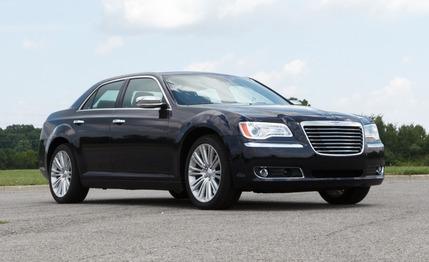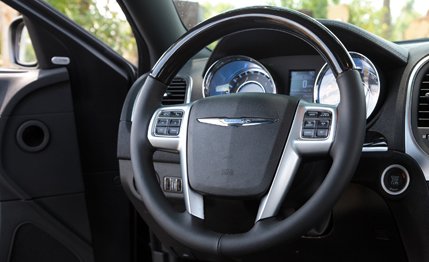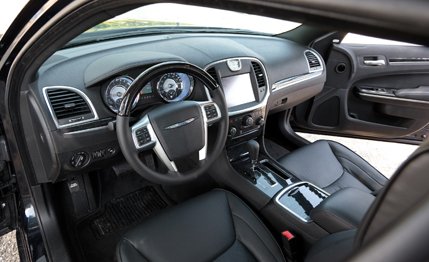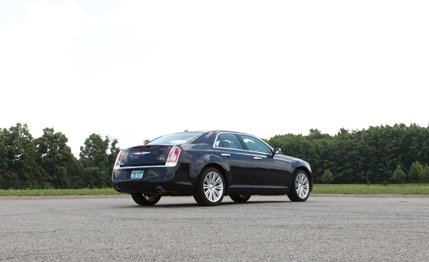 Short Take Road Test
Short Take Road Test

When a car makes the kind of splash that the Chrysler 300 did when it debuted in 2004, its maker gets backed into a corner. Granted, any car company hopes its products will find sales success, but following up an instant icon like the first-gen 300 makes an already tough task—simply designing a car in the first place—that much more of a challenge. Improvements and refinements will of course be made, but where and to what extent?
Further complicating matters, Chrysler had to deal with that whole bankruptcy thing, and so the 2011 300 received more of a thorough face lift than the total overhaul for which it was due. But the engineers and designers spent the short amount of time and little money they were allotted wisely. They comprehensively overhauled the interior, tidied up the exterior (including slight visibility improvements), tweaked the suspension for a smoother ride, and added sound insulation for a more hushed cabin. The 300 might not be as “all-new” as we’d like—or as much as it would have been under different circumstances—but it is once again a compelling full-size luxury car.
Successfully Redesigning an Icon
Refined, polished, and more sophisticated are descriptors that come to mind after studying the 2011 300’s new sheetmetal. Its muscular fenders remain, as does the basic shape of its greenhouse, albeit with thinner A-pillars for improved visibility. The beltline crease is more pronounced and now finds itself running above, rather than through, the door handles. The 300’s nose, cradling Chrysler’s new corporate grille and badge, was designed to appear smaller than before to make the new car look more streamlined. Shapelier lighting elements with LED running lamps and optional xenon bulbs bring the 300C up-to-date with current illumination trends. Its stern is now cleaner, too, with exhaust finishers integrated into the valance and a chrome bar connecting the taillights—although the latter look overwrought with the shiny stuff laid inside the lenses. The 300C still looks commanding and is immediately recognizable, though, as if the old model had found a fine tailor to sharpen up its off-the-rack suit.

The most dramatic change happened inside the cabin. Hard plastics have been banished, the fresh soft-touch materials in their place imparting a much richer feel. The driver sits before an elegant instrument cluster with beautiful detailing that seems more fitting of a concept car than something mass produced, and all occupants are treated to plenty of space and comfortable seats. No one inside can miss the standard 8.4-inch touchscreen display. It’s very responsive, with an intuitive menu structure that allows easy fine-tuning of audio, climate, navigation—a Garmin-based setup is standard here—and vehicle settings. A few redundant hard controls for the stereo and HVAC system are located just below the screen. Some of the brightly colored large-print graphics on the screen look a little cartoonish, but functionally, this setup is a model we wish every infotainment system would follow.
Still an Enjoyable Drive
The 2011 300C driving experience is much like the 2011 car’s stylistic updates: a lot of the same, but with many of the rough edges sanded off. The 5.7-liter Hemi V-8 continues to satisfy and, thanks to its revised exhaust system, now has a smidge more output: 363 hp and 394 lb-ft of torque, increases of 3 and 5, respectively. At idle, the Hemi still shimmies, and it’s hooked to a carry-over five-speed automatic. An eight-speed is coming soon and should help the V-8 achieve better fuel economy than the 17 mpg we observed. That swap should also help the C’s performance: The car tested here paced a last-generation 300C, hitting 60 mph in 5.9 seconds and running the quarter-mile in 14.4 at 98 mph. (In our initial road test of the 300C, we recorded a 0-to-60 dash of 5.3 seconds, but we never came close to duplicating that time in subsequent tests.) That the 2011 model could post similar numbers is a little bit surprising, though, considering that it weighs 300 more pounds.
On the skidpad, the 300C was held to 0.80 g by a stability-control system that wouldn’t get completely out of the way. The brakes did a commendable job of halting almost 4400 pounds of brutish Chrysler, stopping the 300C from 70 mph to 0 in 181 feet.

Although this latest 300C’s performance numbers impress, it’s on the daily commute where it comes into its own. The brakes are easy to modulate and never grabby, and the relaxed steering is perfectly suited to long-distance cruising. Aside from thonging from the tires over particularly nasty craters and lumps, the 300C is rather serene inside. Insulated underbody trays, an acoustic windshield, and double-pane glass cut noise. The suspension was revised with geometry improvements and bits like new springs and monotube shocks, larger anti-roll bars, and upgraded bushings. As fitted to our test car, the Touring suspension—a requirement with the 20-inch wheels—offers taut body control.
A Good Value
The Hemi-powered 300C’s base price of $38,995 is an increase of $235 over the 2010 model’s. The 2011 300C includes standard keyless entry, remote start, rain-sensing wipers, leather seats with four-up heaters and cooling in the front, a heated steering wheel, a rearview camera, navigation, and a power rear sunshade. There are just a handful of options, most of which were fitted to our test car. The Monroney rundown included a pearlescent paint job ($295), polished 20-inch wheels ($995), a dual-pane panoramic sunroof ($1295), and the SafetyTec package ($2795). The latter added power mirrors, automatically leveling xenon headlights, rear fog lights, forward collision warning, a blind-spot monitoring system, adaptive cruise control, and front and rear parking sensors. Given that visibility is still pretty poor all around and the adaptive cruise can be disabled (hurray!), we’d keep the safety package but might forgo the panoramic sunroof to save $1295 of the $44,375 necessary to duplicate this test car.

Given that the 2011 model constitutes a major refresh, we find ourselves wondering: How good could the 300 be with appropriate development time and funding for a full redesign? To be sure, Chrysler’s execution of this car puts pressure on the company to deliver the goods. For now, at least it’s out of the corner.